The perennial plant breeder and environmental ethicist Wes Jackson once said, “If your life’s work can be accomplished in your lifetime, you’re not thinking big enough.” The joy of working on something that is bigger than you and which connects you to the web of life is shared by all plant breeders and seed savers.
Being linked to the reproductive cycles in your ecology through the application of consciousness, vision and hard work is truly rewarding. It takes being attuned to the changing conditions in your environment and applying imagination for how the world could become, before acting mindfully to bring it about.
I was inspired by the link between plant breeding, food and ecology from an episode of Chef´s Table that profiled the ethical and sustainable food philosophy of chef Dan Barber. His vision is of chefs and plant breeders as keystone species in our ecology who steward adapting cultivars while creating more beautiful interactions between people and what they eat. This includes taking the entire farm and its ecology into mind, including regenerating the soil which is the cornerstone of great tasting and nutrient dense food.
Dan had worked with plant breeder Michael Mazourek of Cornell University who bred the famous Honeynut pumpkin. Honeynut is not only a hybrid between two varieties of one species, but also a stable de-hybridized cross between two different species: Buttercup C. maxima and Butternut C. mustachata.

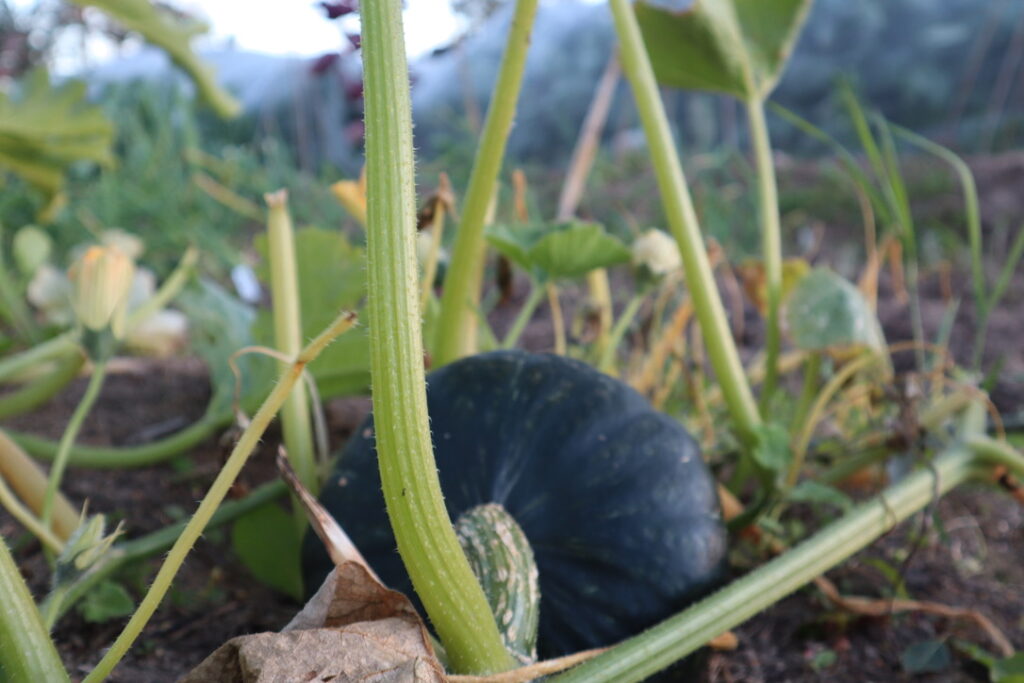
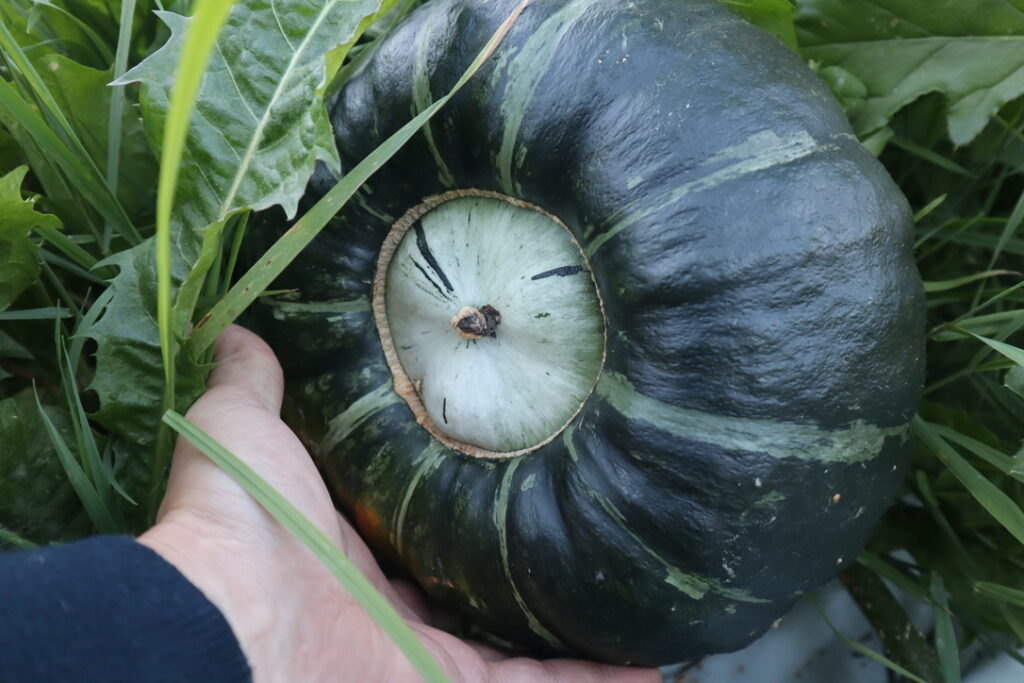
The idea of de-hybridization was something I was inspired to try when I read Carol Deppe´s book Breed Your Own Vegetable Varieties. To de-hybridize simply means continuing to grow out generation after generation of the material one is working on, while selecting out any undesirable traits. Once the next generation is more or less identical to the last, you have achieved an “open pollinated” variety and the de-hybridization process is done. This is also where I got the idea to start work on breeding my own pumpkins. She made it seem quite easy despite being a process that would clearly take several years to complete but would result in a new locally adapted cultivar.
I grew about 50 varieties of pumpkins for the first few years in search for the right varieties from which I might eventually breed my own locally adapted variety. I trailed varieties of all the five main domesticated species: Cucurbita pepo (Spaghetti squash, Mandan, Zucchini and hulless seeded varieties), C. maxima (Hubbard, Buttercup, and winter squashes), C. agryosperma formerly called mixta (Apache Giant, Navajo cushaw) and C. moschata (Musquee de province, Butternut). The fifth C. ficifolia I have largely ignored, although it has sent me in the direction of the Gourd tribe which is within the greater Cucurbitaceae Family of which Cucuzzi Gourd (Lagenaria siceraria) is my favorite for food, and the Bottle Gourd (Lagenaria siceraria) my favourite for the history of being possibly the first cultivated plant and its multiple uses.
The most popular and diverse species is C. pepo and I focused my first real seed saving project on the pepo variety of Mandan Squash. Through many trials I realized that the good tasting squash was in the maxima and moschata species. Moschata tend to take more time and need more heat as they are from further south in the Americas. I therefore abandoned most varieties of moschata except those that are quicker to mature like Butternut and Honeynut.
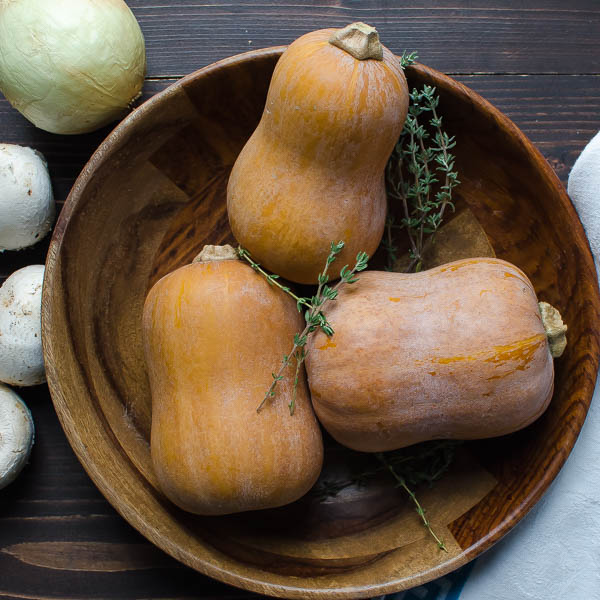
I ended up contacting Michael Mazourek and asked him for advice about what I should use as the father and mother for my new breed. I knew that, like Michael, I would use Buttercup genes for one half of the mix due not only to its superior taste, but also because it’s a short season variety. Buttercup was discovered as a chance seedling in 1925 by the North Dakota State University Agricultural Experiment Station. As it was bred to grow in the Northern Great Plains, it is well suited to the Nordic climate where I farm.
Michael advised against crossing two species as he did with Honeynut. Instead, he suggested finding a smaller short-seasoned bush variety as the other parent, but one that is also C. maxima and will thus cross without artificial breeding.
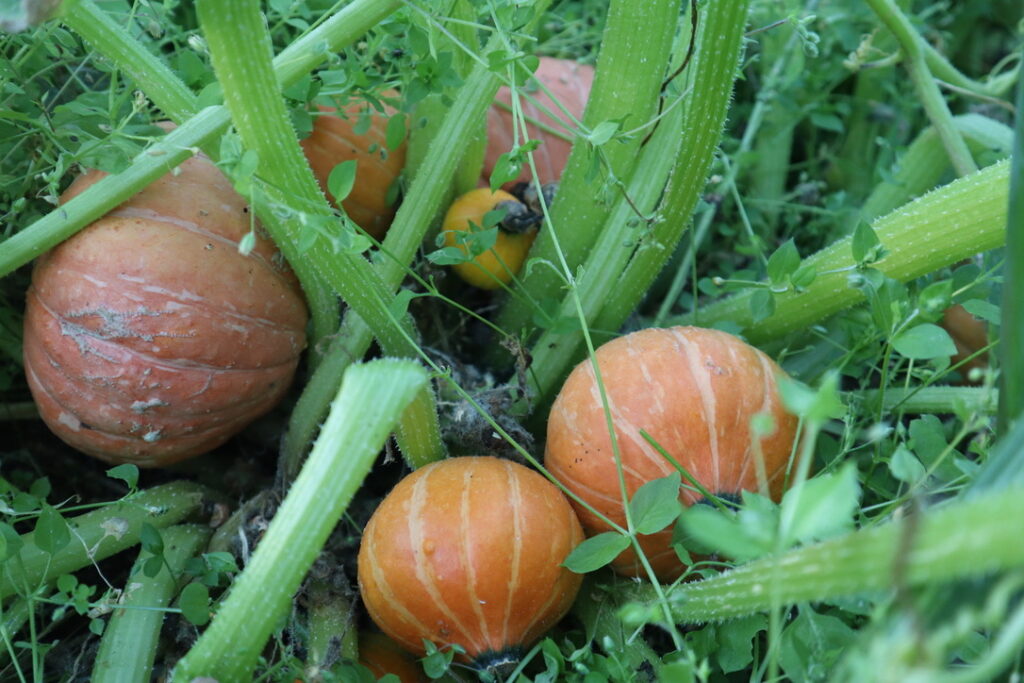
The result is a lovely mix of expressions of both parents. I grew them out alongside more of the parent varieties. I did this for two reasons: firstly, because I was not sure how the cross would look or work, and secondly, because I wanted to add waves to the mix of first-generation crosses “F1” and second-generation crosses “F2”. This fits into one of the principles of doing things in waves instead of straight lines like most productive agricultural practice (read more about waves in my blog article Ecological Bottlenecks ). The hybrid vigor along with great conditions these past years have given the best outdoor results I have seen. We grow them in the traditional Milpa or three sisters with corn, beans and a host of other plants like sunflowers, lettuce and alliums.
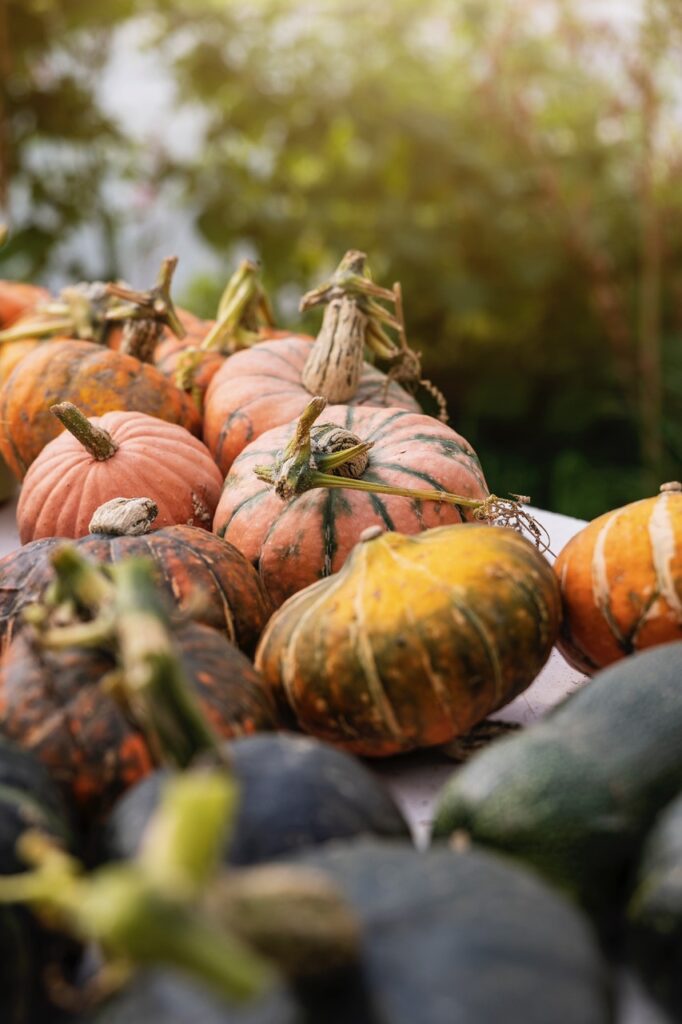
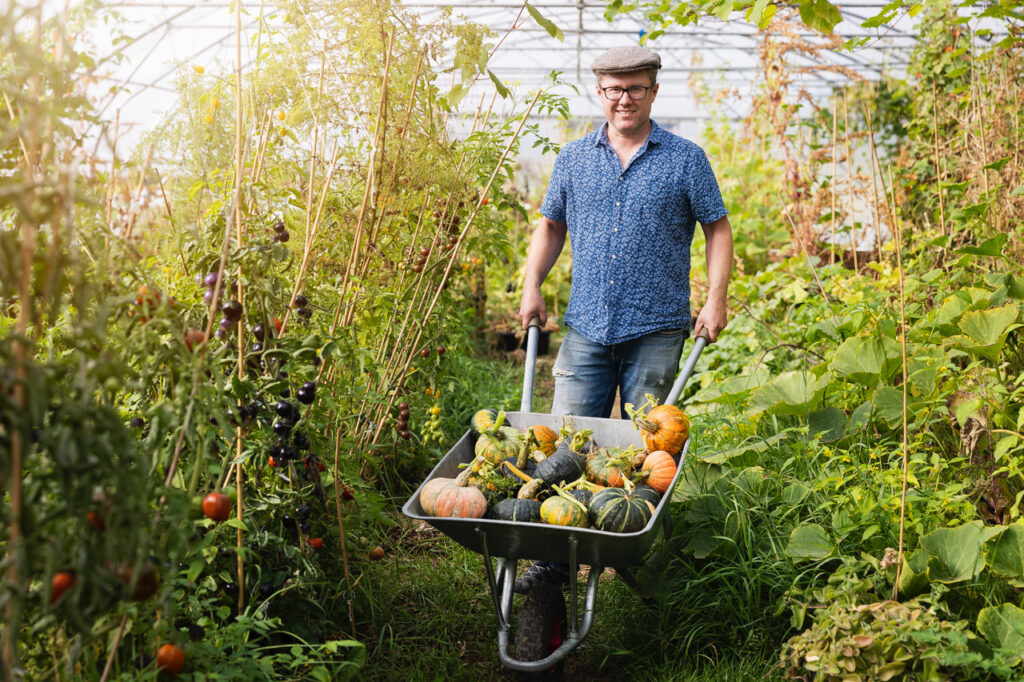
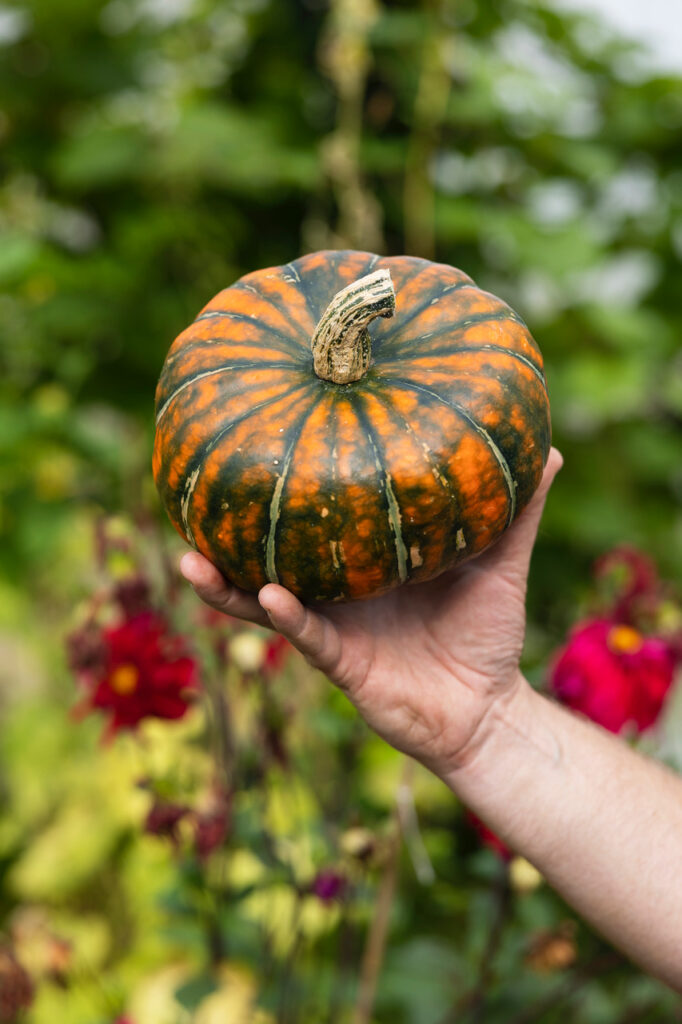
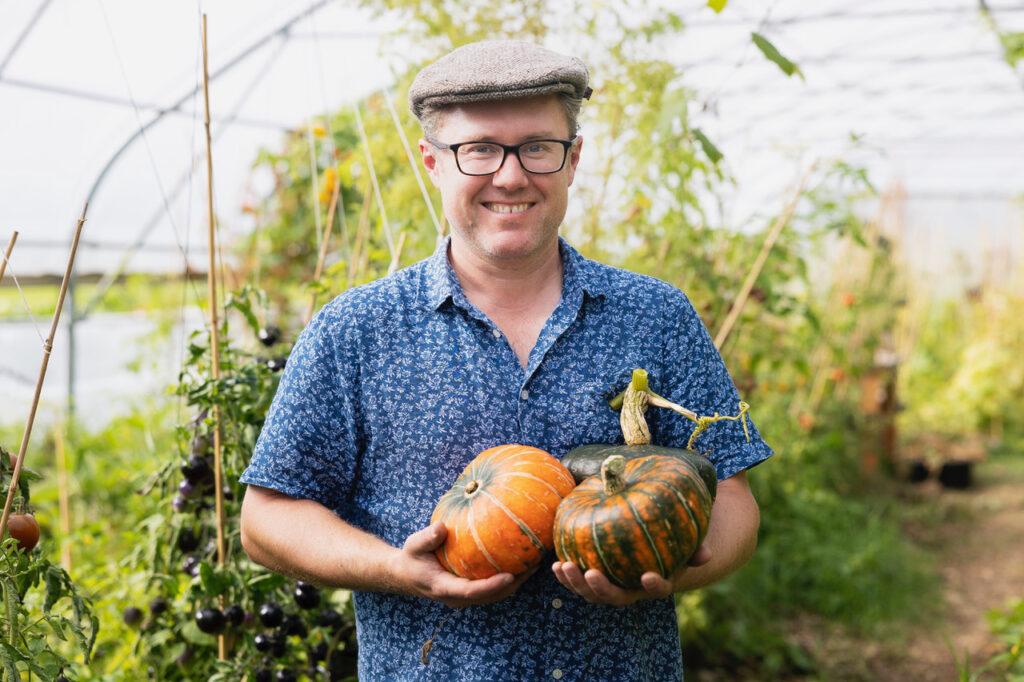
In the fall of 2022 Dagens Næringsliv did an interview on me profiling Meltingcup in Jakten på den Mest Potente Gresskaret. I am excited to think about how this project will evolve. For now, I am simply happy to be seeing great results, which has not always been the case in previous projects. It takes a lot of failing, time, and devotion to create something new that will last. Being stewards of our ecological inheritance is not just about taking care of rare heirlooms, but also creating heirlooms for the future that are in constant co-evolution and adaptation to the rapidly changing climate. I hope stories like these inspire more people to connect to their ecology in active positive ways. There are far too few keystones these days, but the potential is for all of us to be just that.
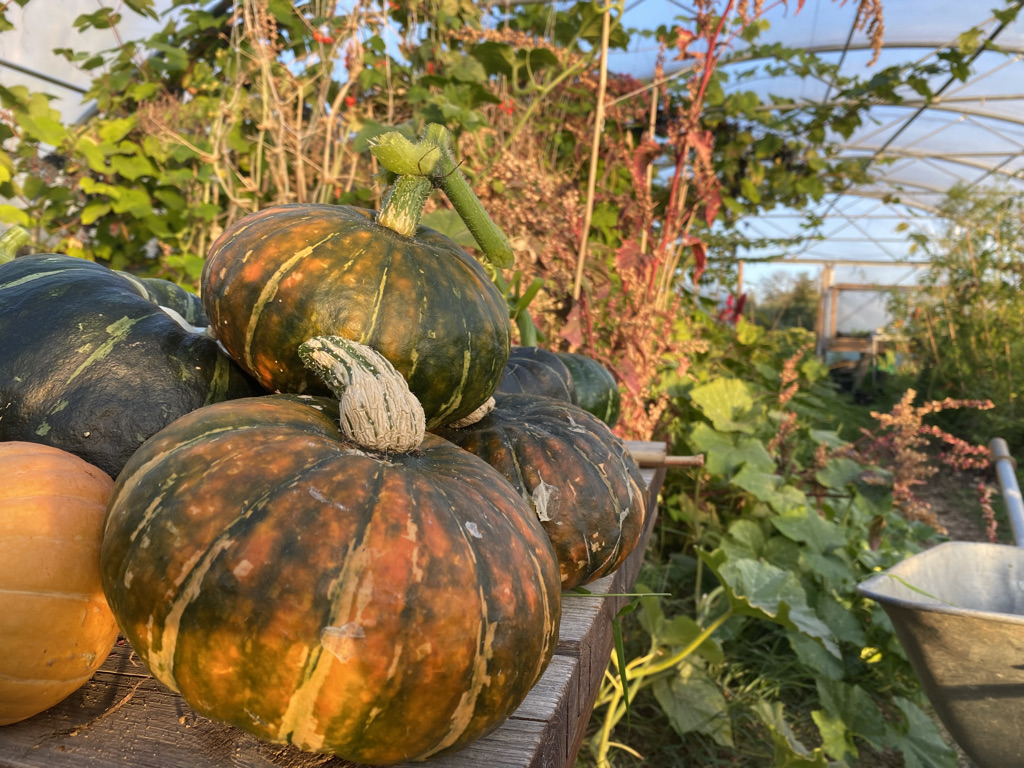
When to plant and harvest
I get asked often when is the best time to plant and harvest pumpkins. The general rule is that the pumpkins you want to save seeds from should have as long a season on the plant as possible. So I always watch the timing closely in the spring. I pre-cultivate plants for about two weeks in the greenhouse before I put them into the field, which means you need to time it quite precisely. You dont want too small plants that are late, and you dont want too mature plants that are early. Cucurbits grow really quickly under ideal conditions and if the dont get ideal conditions, they dont live up to their potential either. So getting the sowing and seed saving just right is more of an art than with many other vegetables.
Sprouting and planting
Ancient indigenous wisdom is the best place to start when trying to learn what is the best practice to follow. Buffalo Bird Woman´s Garden is a great source of information on how the Hidatsa tribe cultivated their plants. The chapter on squash shows the techniques and timing which I more or less copy. They sprouted seeds from mid to late May or early June by wetting the seeds in a bundle protected by buffalo hide which they hung near the fire. Once they sprout, they plant them in the field.
I copy this by sprouting seeds at 22-26 celcius in a humid bag. Once they sprout I plant them in individual pots and keep them in the greenhouse for a few weeks till they are strong enough to be planted out. Once in the filed it’s critical that they dont freeze. I’ve experienced down to 1,5 celcius and the plants made it through the night. Always be watching the nighttime temperatures as that is the bottleneck. The soil should be above 10 celcius before even thinking about planting in the field.
Harvesting
I do everything in waves instead of all at once. This is a much more natural way to interact with your ecosystem which you can read more about in Ecosystems Resonance. I start harvesting for eating once I see pumpkins that look good to eat, but only take what I need for that day. These are not mature and there is no point saving seeds from these. By September you can see some pumpkins where the stem or “umbilical cord” that connects the fruit to the plant start to dry out and turn from green to brown. This is a sign that the fruit is starting to mature. I begin harvesting the ones that I dont want to save seeds from, but which are mature, along with any damaged fruit. This gives the other fruit on the same plants more time to mature. September is the month where they really grow in size, so you dont want to start too early. By the end of September, I have most of the fruit harvested. I dont bother harvesting the little fruit or trimming the plants. If you have only a few plants, maybe this is worth it, but I have so many that this makes no sense. I also like plants to grow as they would in nature as much as possible.
As I harvest more and more waves of pumpkins I eat and store as well as trade and sell. I am open about the fact that I am keeping the best ones for myself, since this is a breeding project aimed at reproducing top quality seeds.
Selection criteria, food, storage and seed saving
One of the nice things about pumpkins is that you can save seeds and eat the fruit at the same time, which is not the case for other cucurbits like squash and cucumbers, or nightshades like tomatoes.
This is a form of stacking functions which gives pumpkins an extra star in my book. In fact, the longer you let them mature, the better the seeds get and the meat cures well in the process. Meltingcup is not the best variety for storage. The best variety is Nanticoke Squash in my experience, which is still good eating after 9 months if stored properly. Meltingcup lasts anywhere from 3 to 5 months on average at room temperature. The best months are November and December for tast, as you get the sweet spot of maturity in fruit and seeds. Seed quality just gets better and better the longer you let them store, with February and March being the peak. By then you can see some mold forming on the pumpkins which one simply removes before cooking.
My strategy is to always eat the immature and damaged fruit first. Then I sell, trade, or gift the pumpkins that are good to eat but don’t fit the selection criteria. I store the very best pumpkins in windows, tables, shelves and ledges in the house through the winter, which gives a lovely feeling of connection to what I eat while also being works of art that can be looked at with reverence and joy throughout the winter. Looking at them both connects you to them but also keeps you aware of which ones are starting to deteriorate. Always eat the deteriorating ones first and save seeds from them. This way you can gradually save seeds and eat amazing meals while also quality controlling each individual fruit so that you select for the traits you want to bring with you into the next season.
Selection criteria
Looks: I want a perfect melting of green and orange with some white stripes and preferably also the turban base. This is the perfect individual on that score, which I call the “Acorn Meltingcup” as it resembles a beautifully painted work of art. It happened to taste great and had a small seed cavity so it fit all the selection criteria.
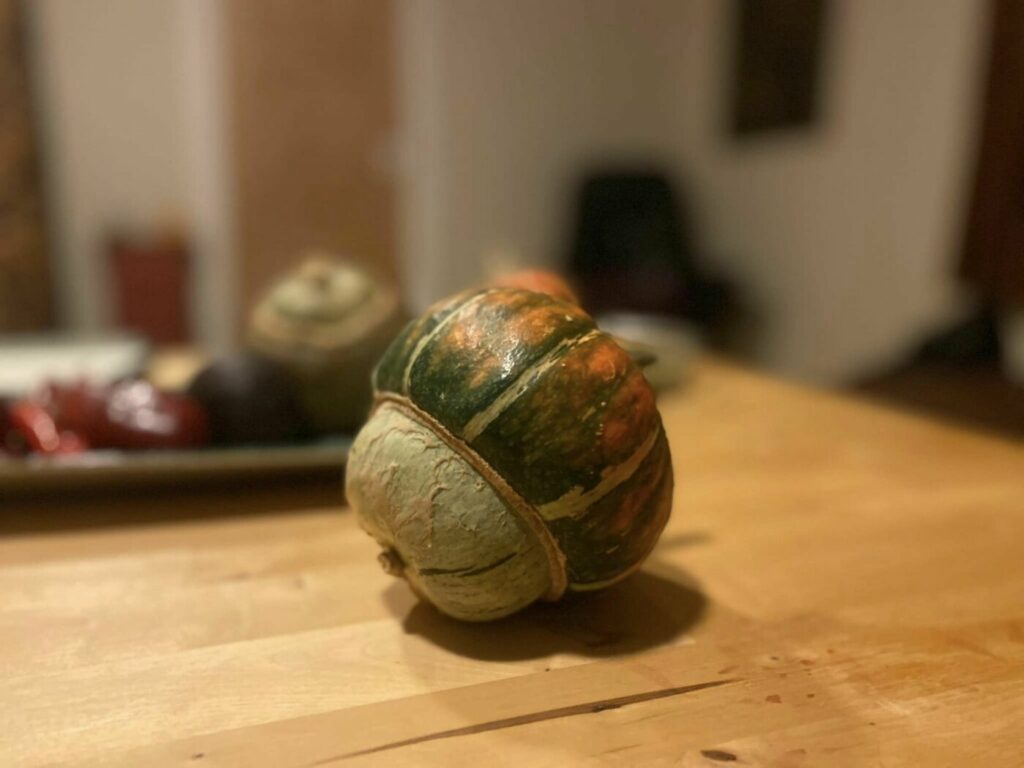
More meat than seeds: Some pumpkins have large seed cavities which means they don’t have a lot of meat. Since I want to eat them, I select individuals with as small a seed cavity as possible.
Bushing, rather than vine: Some varieties tend to bush and some tend to spread out as vines. Meltingcup is a mix of both, but I try to keep seeds from the side that bushes. This is because I grow in long rows and want to be able to keep the pumpkins on the rows and not in the paths as much as possible. My rows are all raised beds, which means that a pumpkin that sits near the base of the plant stays dryer than the ones in the path and don’t tend to rot as easily. They are also less likely to get stepped on if they are in the beds. Also, smaller bush plants can be grown in limited spaces and are appreciated by urban growers.
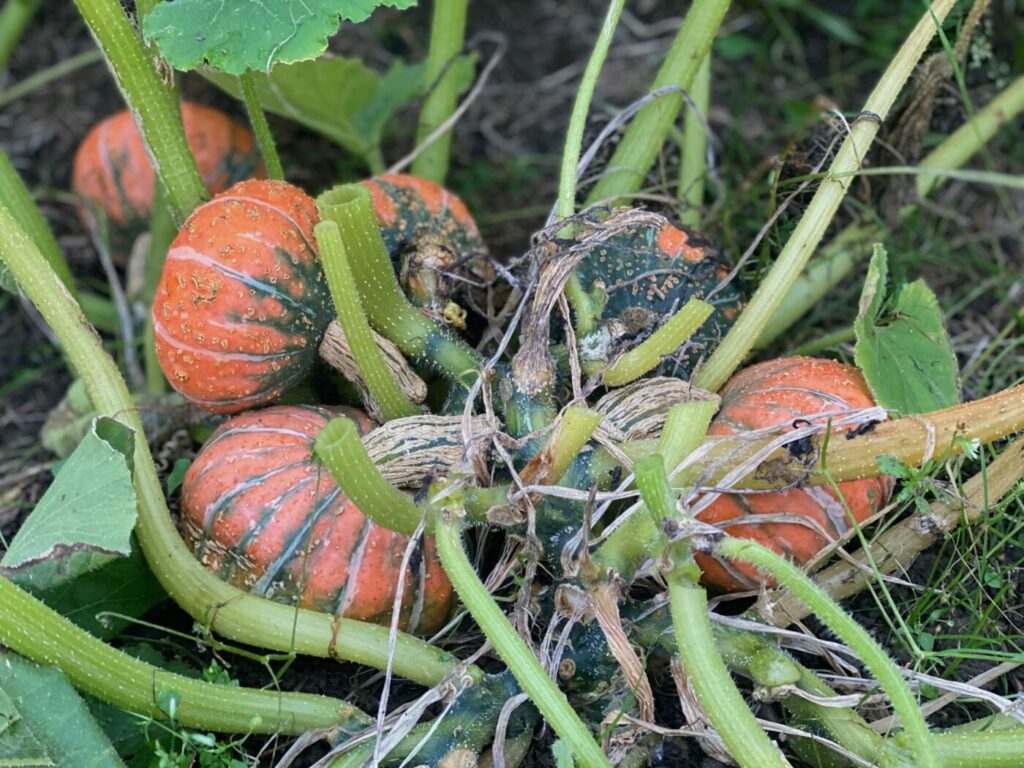
Small is beautiful: I want the fruit to be from 500 grams to 2 kg and not larger. This is because people don’t know what to do with big pumpkins and mostly buy smaller fruit that they can easily prepare. But also because experience has shown me that a fruit that can feed 2-4 people makes sense in the kitchen. You don’t want to spend too much time prepping for a meal or have to store a bunch of pumpkins and eat them for several days. Another benefit is that they can easily be harvested and even simply cut in half and baked as they are in the oven. This is easy and esthetically pleasing for fine dining. Since I sell to restaurants, this size makes sense.
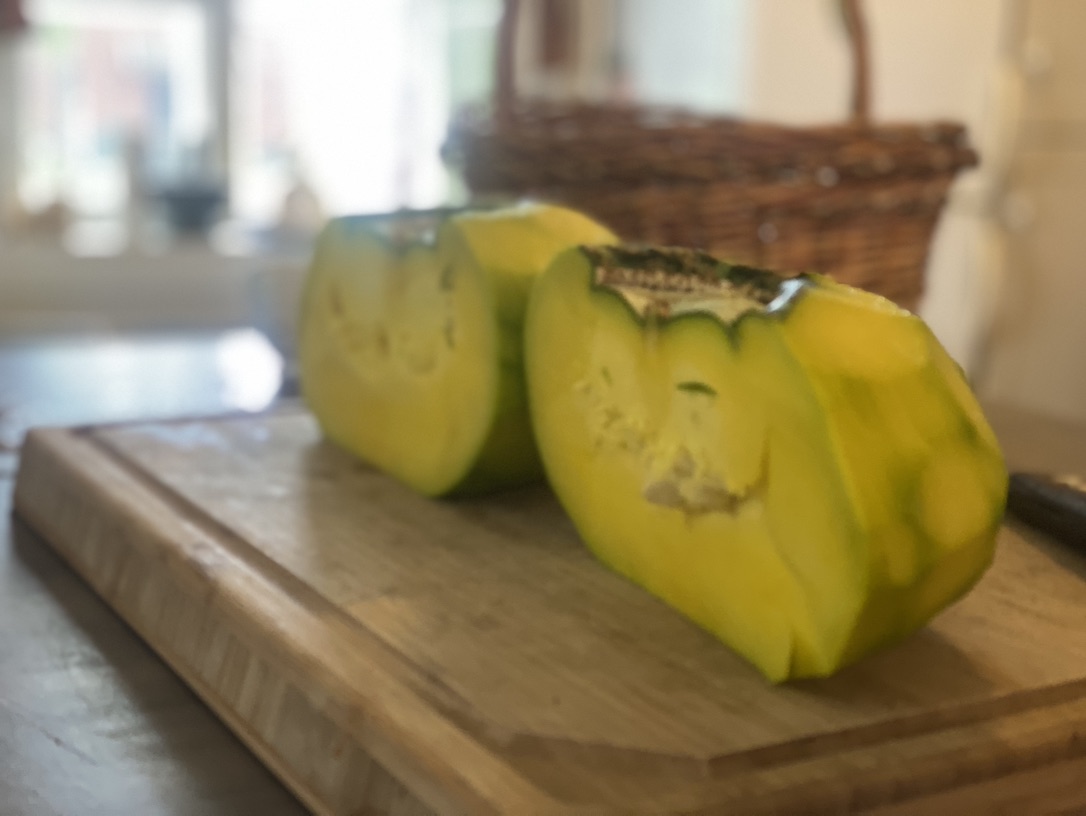
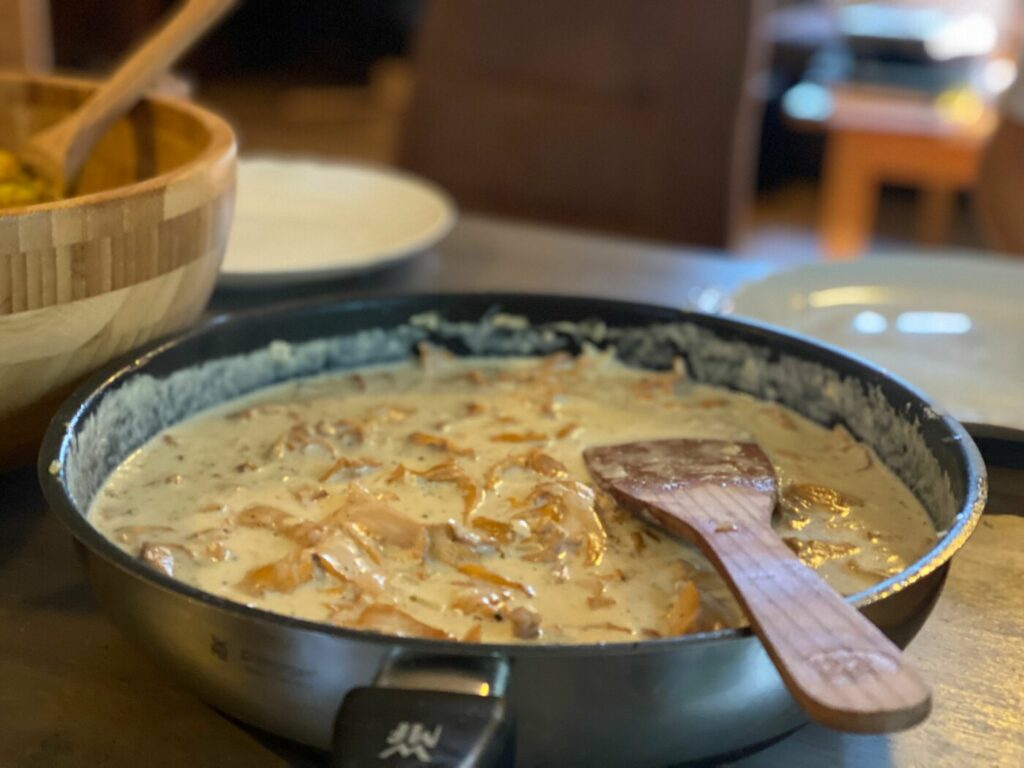
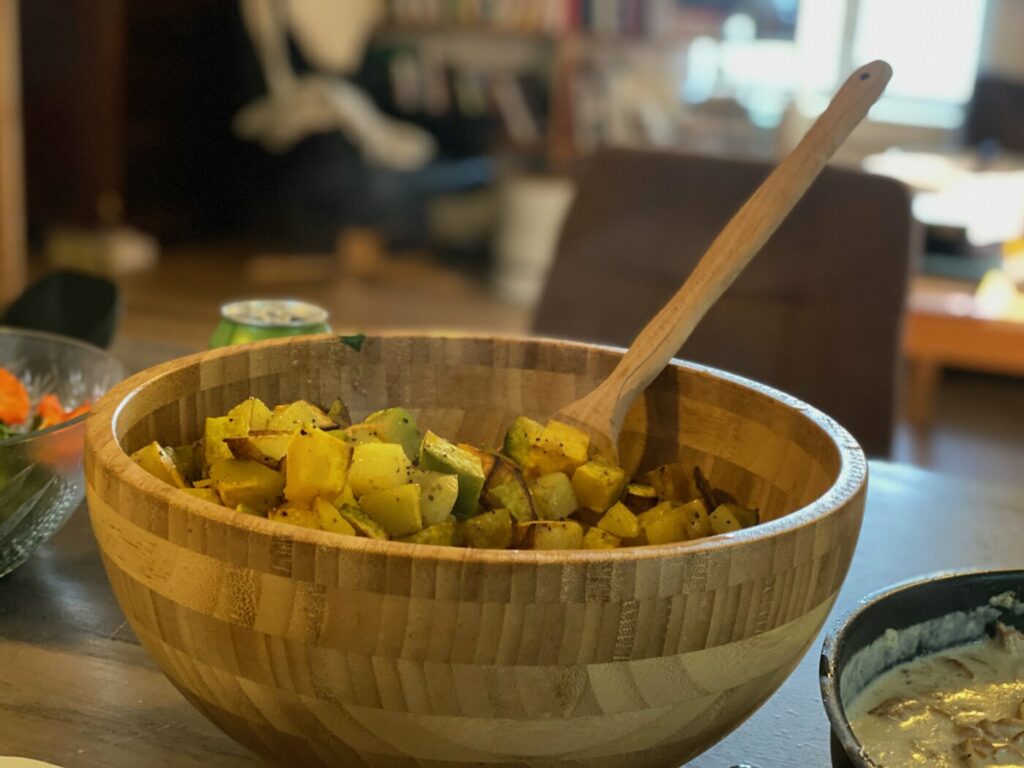
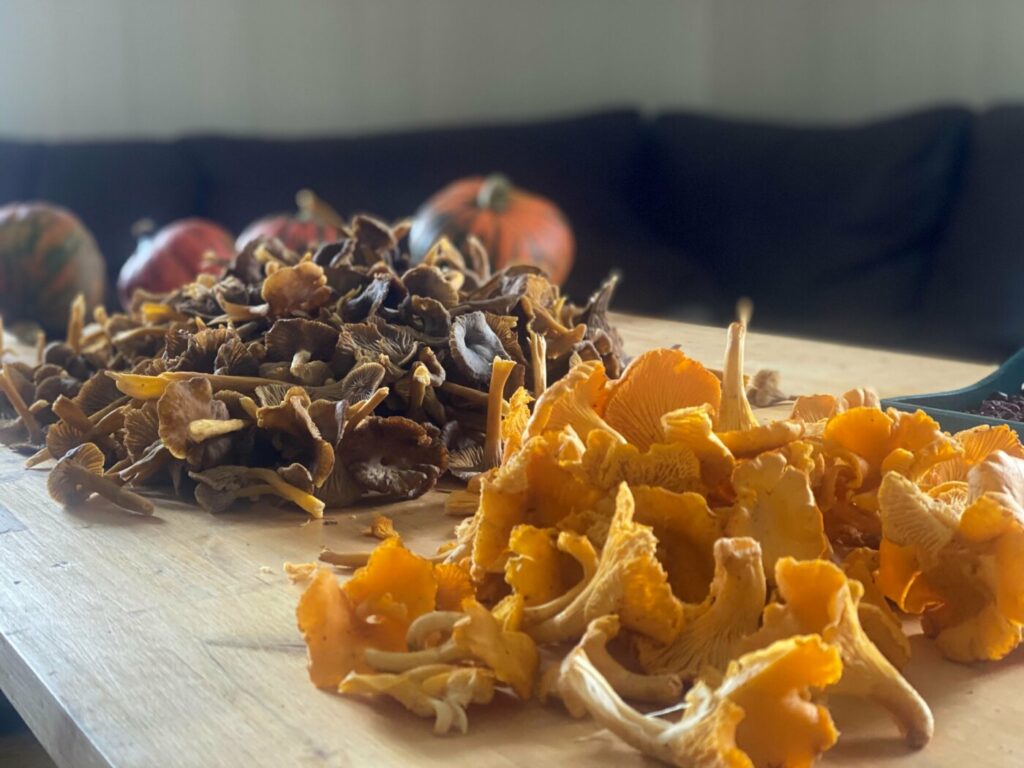
Short season: The prime selection criteria is of course a short season. I want to spread the joy of growing pumpkins all over the North. Most varieties are anywhere from 90-120 days to maturity. This means they will not work for most farms up here. Meltingcup is 80-85 days to maturity, which is as low as I´ve seen and this is the main reason why it is “adapted” to the North.
I get asked often if Meltingcup tolerates frost. The answer to that is simply no. There are no cucurbits that are frost tolerant in my experience. But if anyone knows otherwise, please send me the name of the variety, as that would be something to work towards.
Good eating: It’s not over till the fat lady sings. And boy does she sing when she is sliced and diced and baked in the oven! Most of the time I simply dice pumpkins and potatoes and bake them for 30 min at 200 C in the oven. I add turmeric powder, oil, salt, pepper, and either sesame oil or seeds. Keep it simple. There is so much flavor in this pumpkin that adding too many other flavors hides the quality of this variety.
If you want to add side dishes, I love Chantarelle cream sauce with peas. I happen to grow a Swedish cultivar called Biskopen which is a dry pea. I grow them together with the pumpkins in a Milpa (also known as three sisters) which is an ancient method of growing plants in so-called guilds where one plants needs are provided by the other plants and they form a synergetic guild. The traditional backbone of the Milpa was pumpkins, beans and corn. The corn provided the calories, the beans the protein and the pumpkins a more balanced nutrient spread. The corn provided structure for the beans to climb, the beans provided nitrogen and the pumpkins shaded out the ground forming a total canopy which kept weeds from establishing. Often amaranth, sunflowers and other crops were also included forming five, seven or even eleven sisters.
I substitute peas for beans as they are more prolific and store better than the French beans which are primarily grown for fresh beans. I also use more sunflowers than corn as corn takes more time and can be outcompeted by the pumpkins more easily than sunflowers. The sunflowers are mostly for structure for the peas and beans, as well as beauty, pollinators and seeds for birds, which should always be included in the overall ecosystem plan for any farm.
Recipes for pumpkins
Baked:
Peal and dice the pumpkins and potatoes.
Add vegetable oil, sesame oil, turmeric, salt and pepper.
Bake for 30 minutes at 200 degrees till there is a bit of crisp on the pumpkins. Caramelized pumpkins are better than mushy ones in my view.
Roasted duck goes really well with this recipe for those who are meat eaters.
Soup:
Slow boil bones for several hours with herbs like lovage, salt and pepper. (I get bones from a Holistic farm that I share tools like the two-wheel tractor with which is nearby. You don’t need the broth from the bones, but in the fall the added fat and protein really make a difference for cold weather working where calories can burn fast.)
Boil peas till soft.
Fry diced pumpkins till caramelized.
Add a head or two of garlic.
Add a bunch of onions.
Thinly slice cabbage and fry with onions and garlic.
Add mushrooms (fried for 5 min).
Mix the ingredients and let them simmer for 30 min till the stew forms. Add water as needed.
You can optionally use turnips and fresh green beans as substitutes for cabbage and peas.
Nutrition comparison
Finally, I want to say a few things about nutrients by comparing potatoes to pumpkins. Although the calory count varies between varieties, buttercup have about 35 calories per 100g compared to potatoes with 85 calories per 100g.
In a world of overeating, substituting potatoes for pumpkins, or even mixing them together as I do, significantly reduces the caloric intake. It also spreads the nutrient intake up over a wider range. By adding pumpkins to potatoes, you could as much as half the calories, while boosting vitamin A by 350%. Vitamin A is critical to metabolic health as well as vision and, critically for us in the North, it helps reduce the onset of night-blindness. Eating a naturally rich a source of A vitamin through the winter then, is a health benefit not only to you, but to reducing the chances of accidents and thereby could save lives. Vitamin A strengthens the intestinal lining, reducing IBS and making you more resistant to infections.
Pumpkins also have more B12 and E vitamins than potatoes. E is an antioxidant and enhances smooth muscle growth. B12 is also critical for metabolism and used in DNA synthesis as well as the normal functioning of the nervous and circulatory systems. Both E and C vitamins are good for your skin health.
Being someone who used to suffer from IBS and loving the sunshine of the outdoors, pumpkins are the perfect companion in keeping me healthy. Being high in fiber and potassium they also lower cholesterol and insulin spikes, both of which are issues a lot of us should keep an eye on.
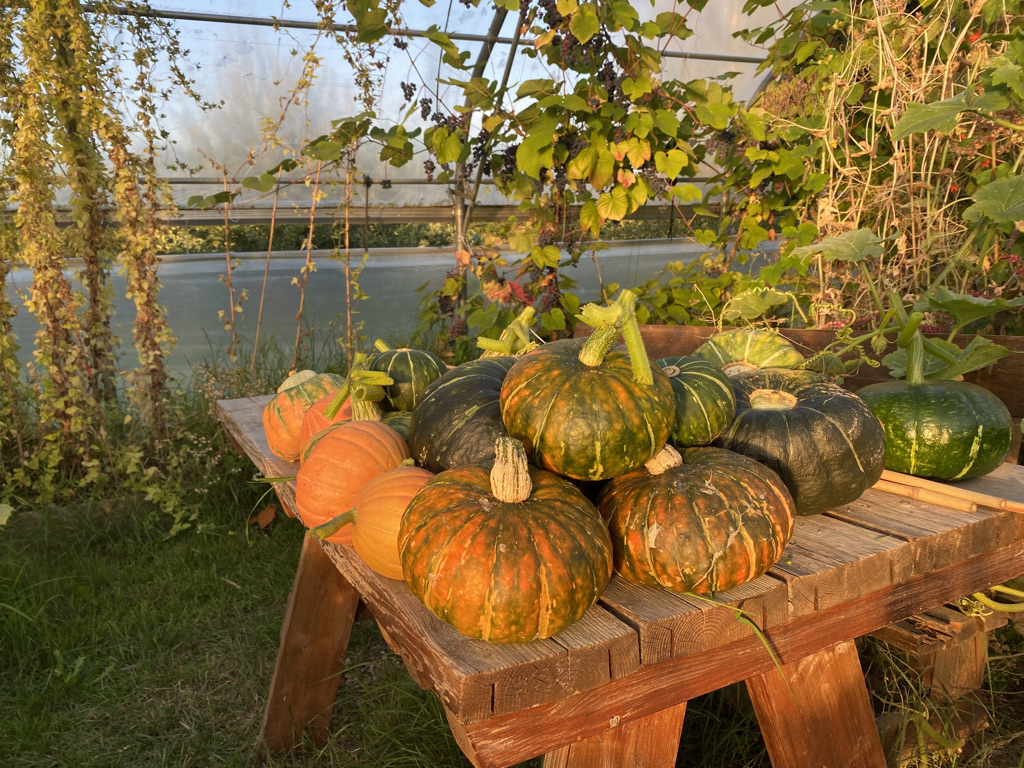

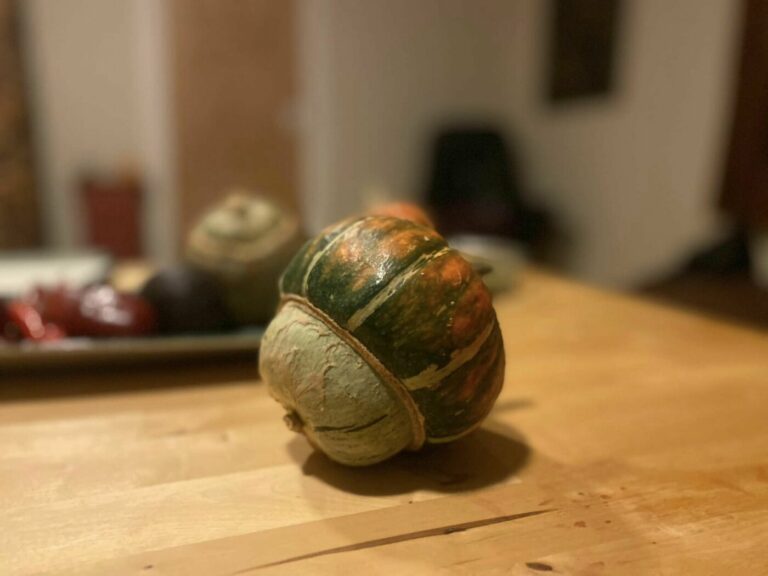
Interesting and important work, thanks for sharing!
Out of curiosity, which was the second parent you decided to use for your cross?
Would be fun to try something similar here in the south of Sweden.
Thanks Christopher. I keep the second half a secret so people dont start stealing my work by registering it as their own cross. I am happy to send you seeds of my cross and you can help me do the de-hybridization work if you like. My work stays with the OSSI-Open Source Seed Initiative and should not be patented.
Hello Andrews, are you familiar with Joseph Lofthouse’s work on short season vegetables which includes squashes? His seeds are also available through OSSI https://osseeds.org/ossi-breeders/Joseph-Lofthouse/
He has also recently published a book on Landrace gardening.
No, I had not heard of Joseph Lofthouse. Thanks for cluing me in. Ill be sure to look into his work.
Great article, thanks! I’ve been crossing quite a few squashes here in Belgium. Sometimes, bees and bumblebees give surprise crosses, too, even between species.
Makes sense to protect against , such a strange place we’re in, where we can patent the genetics of a plant.
I’ll happily give that try, thanks for the offer, I’ll send you a private message.
All the best,
Christopher
Thanks Christopher. Ill share seeds with you if you share your experiences of growing them with me and try to keep reproducing them.
The focus on selecting varieties that thrive in specific climates and soil conditions is both practical and inspiring for farmers and gardeners alike. I especially appreciated the insights into balancing traditional knowledge with modern agricultural techniques. It would be interesting to learn more about success stories or challenges faced in different regions.